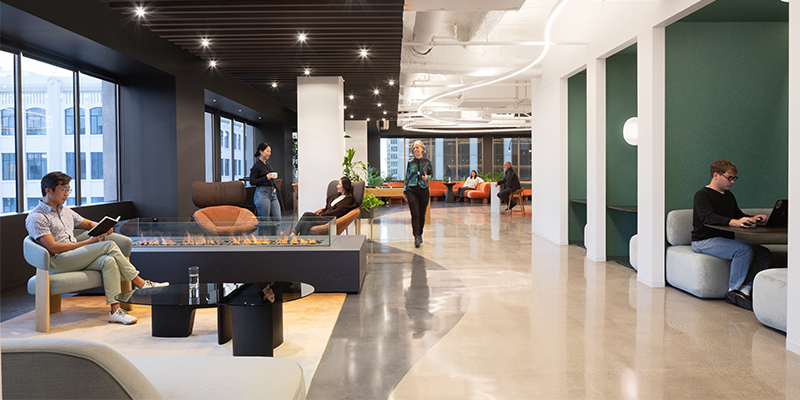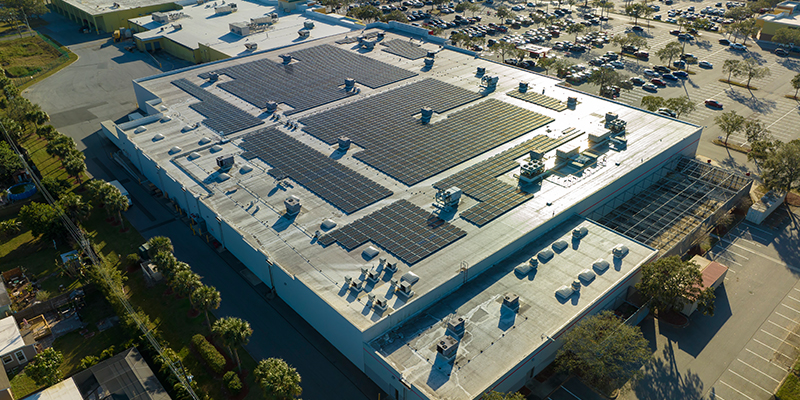The sluggish return to the office, financing and liquidity, and new ways of approaching the office sector were the predominant themes of an elite gathering of C-suite office owners, investors and developers. The conversation, spearheaded by NAIOP and hosted last week in New York City, explored the challenges and opportunities facing the sector.
Here are key takeaways from the event:
Office can learn from other sectors. Look to the retail industry for rebounding inspiration. Despite being labeled “dead” just a few short years ago, retail has reinvented itself by transforming its business model – and it has worked. Office has the same potential for turn around by creating spaces that are an experience, not only a workplace. Flexible workspaces and formats are a must – hot desks, private office and conference rooms are needed, but not equally every day. Don’t underestimate the benefit of “network effects,” or after-hours networking events that are a real draw for tenants and reasons to excite employees about coming to the office. Class A product that offers amenity and community spaces continue to be quickly leased.
Caution: Slow-cession ahead. With sluggish GDP growth of 1-2% and unemployment expected to elevate over the next two years, the economy is experiencing a slow and steady contraction without being considered a full recession. Positive absorption may not occur until two years from now, and structural changes in the capital markets will have a lasting impact over the cyclical changes. An over-abundance of venture capital was deployed into office in 2021, and now companies are right sizing with layoffs and pulling back.
Short-term leases shouldn’t be ignored – and don’t forget the extras. Office is seeing big declines in the number of leases signed as well as their duration, far down from their peak in mid-2019. Few leases are for greater than seven years, with an increasing number ranging around three years. There’s a necessary mind shift to think of office assets as revenue-generating properties by taking advantage of ancillary revenues, reducing exposure to capex, and minimizing expenses long term. Treat tenants like customers who are willing to pay premiums for flexibility (this has been proven in coworking centers, where tenants pay steep prices for a short-term solution). It’s not “If you build it, they will come” so much as it is “If you operate well and please tenants, they will stay.”
The 5-day-in-office work week is gone. Hybrid workplaces are here to stay, with office users settling on three or four days in the office, although user rates are still very fluid. This makes it difficult to recalibrate debt rolling over at a time when mass vacancies are expected to continue. The financial services industry and tech workers are returning to the offices in droves – some by choice, some by mandate. Young workers piled up in small urban apartments want to be back more full-time, while seasoned workers who simply replicated their office environment in extra square footage at home are resisting lengthy, daily commutes from the suburbs.
The cost of capital has changed for the entire industry. A significant amount of office (and also multifamily) was developed during periods of low interest rates and is coming out of the debt cycle at much higher rates. Asset capitalizations have to be performed across the industry – this stress can cause a lot of confusion but creates immense opportunity. The cost of construction and capital markets are driving astronomical rents in key spaces, and new inventory is going to be slim. Liquidity for high-value assets is available – and mostly from foreign investors as high-net worth individuals explore buying lower tier assets.
Decentralizing may be on the horizon. Extremely high-end, well-located spaces that are $300 per square foot may be swapped for leases in more offbeat locations that ring in at $90 per square foot, with extra cash being invested in tenant improvements and upgrading the amenities. Miami, Nashville, Austin and Palm Beach are capitalizing on the exodus out of Manhattan and San Francisco. Quality of life, education and affordability are all drivers, but some areas (Miami) are housing constrained. Some companies are finding split headquarters to be effective (executives in city centers and administrative workers like accountants and marketing teams based in suburbs or entirely outsourced). Don’t count out Manhattan quite yet – it’s legendary style of living and working can’t be replicated anywhere else, and companies like Google and Facebook are leaving California and relocating to New York because their young workforces want to be there.
Social capital matters. Young employees who have chosen to come back to the office on a more full-time basis are reaping the rewards of more exposure to executives and facetime with clients. Occasional happy hours with the team don’t allow up-and-coming executives to demonstrate their same level of skill and knowledge as do daily interactions with colleagues.
Public-private partnerships will play a significant role. Holistic approaches that include private-partnerships will be essential in revitalizing central business districts and attracting tenants and employees. Surrounding amenities, safety and quality of life issues can have a dramatic impact on the value of office properties and, in turn, the amount of tax revenue generated.
Not all buildings are ripe for conversion. Converting brown offices to green apartments sounds ideal, but roughly 10% of office buildings are plausible candidates. Zoning changes and incentives can help make the economics of conversions feasible. Location matters and it varies by urban and suburban markets – in are walkable amenities, convenience retail, transportation and parking; out are dead walls and ally views. Older buildings with deep floor plates, non-operable windows and lack of curb appeal are challenging, but often come with tall ceiling heights, plentiful parking, and shorter construction schedules. A popular and unique new amenity to consider: in-building or close by childcare facilities offered with priority to residents. Multifamily expectations will continue to evolve and office demand will stabilize, so there’s an underlying threat of over-converting.
The success of the office sector is key to NAIOP’s mission and roots, with our members engaging in the development, brokerage and service of the sector since early in the association’s history. Read more about the future of office in the summer 2023 issue of Development magazine and explore on-demand courses and upcoming webinars on the topic. If you’re interested in participating in future small-format conversations on office, let us know.








